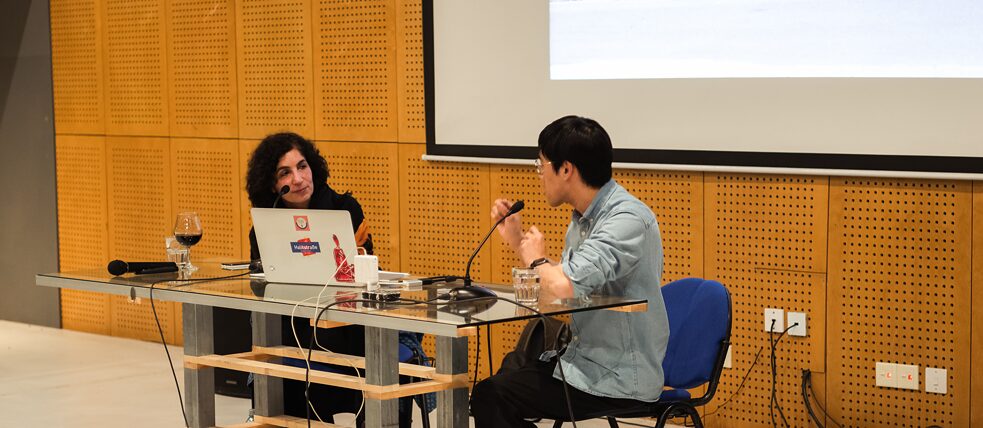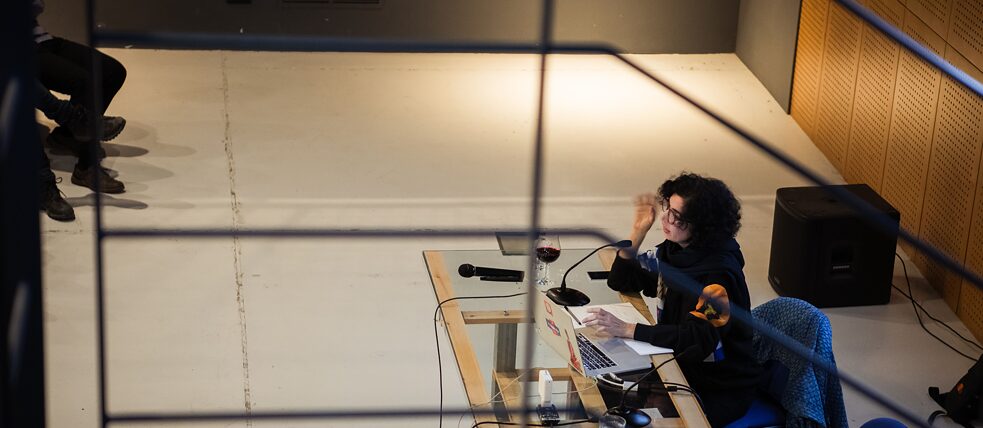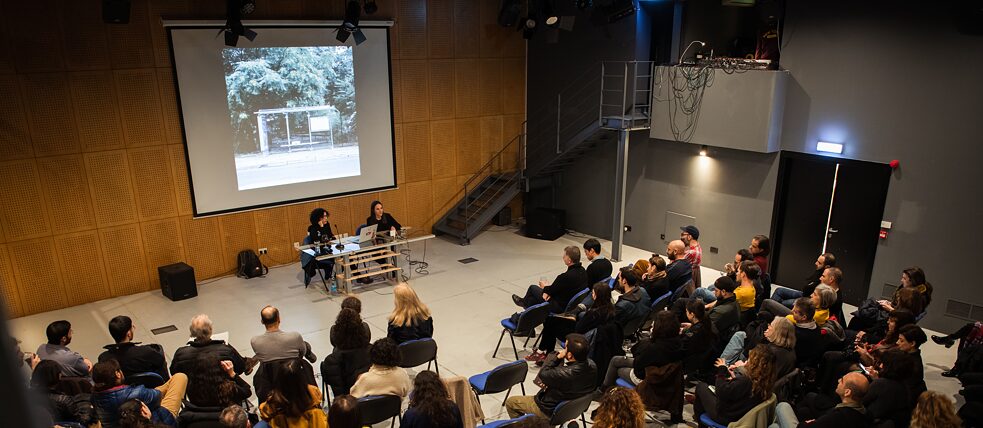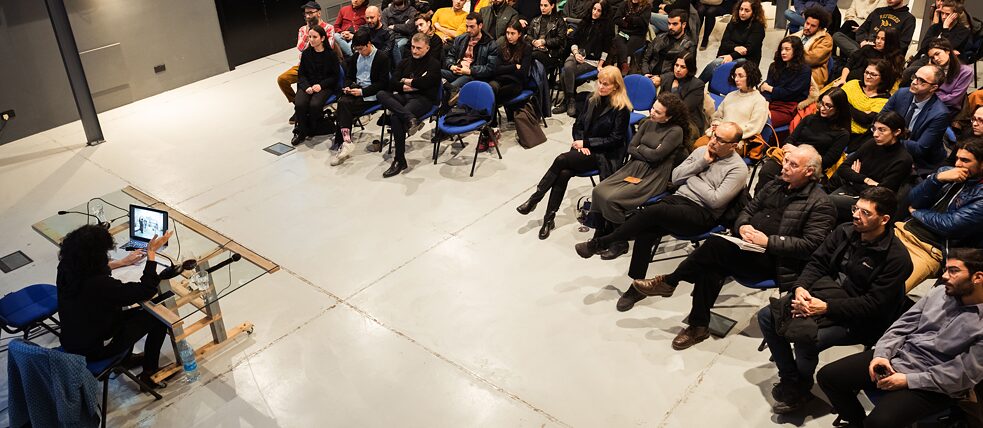Interview
Natascha Sadr Haghighian: Between places
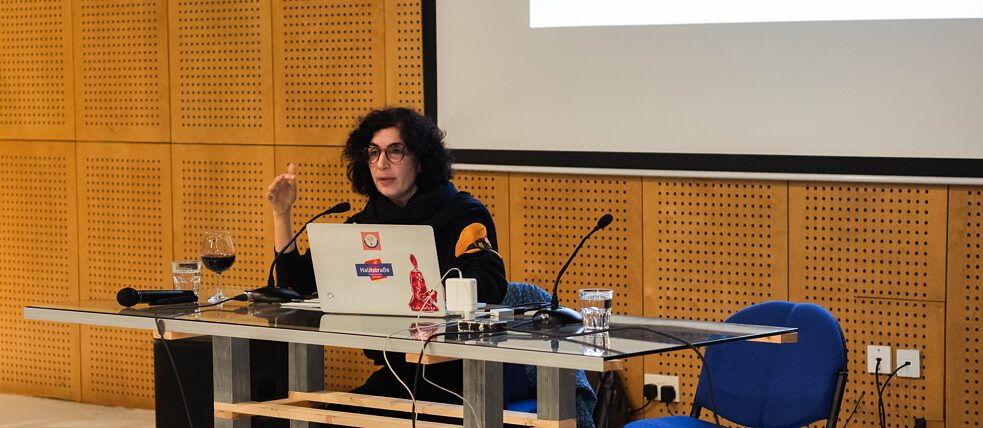
“I have abandoned the idea of origin because the concept is used in such a toxic way nowadays,” notes the artist, who uses multiple identities as part of her work.
Natascha Sadr Haghighian represented Germany at the Venice Biennale 2019, which ended last November. In her highly political work, the artist uses performance, installation, sound and speech to explore themes related to culture, identity and the concept of belonging. She was in Cyprus as part of the Hypersurfacing exhibition forum at the Nicosia Municipal Arts Centre, where she presented her work on January 23rd and held a four-day workshop with the artists participating in the exhibition: Raissa Angeli, Natalie Yiaxi, Stelios Kallinikou, Lito Kattou, Phanos Kyriakou, Orestis Lazouras, Marina Xenofontos, Nayia Savva, Constantinos Taliotis, Maria Toumazou, Leontios Toumbouris and Peter Eramian.
What is the workshop aim for you and what do you wish for the participating artists to get out of it?
The curator of the Hypersurfacing exhibition, Marina Christodoulidou, invited me with the idea of my becoming familiar with the exhibition and the practices of the artists involved and then giving my own perspective on the concept of hypersurfacing: what a surface is, and what it means when something becomes apparent.
We discussed these concepts. For example, yesterday we read a text that may be a kind of deviation from the immediate concept of hypersurfacing as it is dealt with in the exhibition, taking it to another level. We read a text by Rijin Sahakian entitled “Extraction Rebellion”, looking at mining as a means of emergence, albeit a rather violent type of emergence. Then we discussed what it means when something comes to the surface voluntarily or when it is extracted. This was something I personally considered important, because mining plays a big role in the places that interest me.
I don’t think a four-day workshop has to focus on production, especially if it’s a conceptual issue. And I believe the artists did a fantastic job responding to the concept proposed by Marina. Moreover, I believe that they are at a point in their practice where they do not need anyone to encourage them to produce in this way. I don’t need to teach them how to do things. It’s more of a discussion and feedback, and I think its effect will somehow resonate in what they do next.
What challenges do you face in your work? What shared challenges do you think artists face who deal with political issues?
I think we live in times where it is rather difficult not to deal with political issues in one way or another, whether they are directly part of our work or simply shape the circumstances. I am very privileged to have dual citizenship – and the German passport is very privileged in terms of mobility – but many of my friends have to constantly apply for a visa to participate in exhibitions. I would say that this is a political issue, so there are many levels to artists’ work. And if you ask me, personally, these issues disturb me and concern me a lot. There are different mobility issues for different artists.
According to Wikipedia you were born in Teheran. Has your Iranian background influenced your work in any way?
I have abandoned the idea of origin. I am not interested in ancestry, because its meaning is nowadays used in such a toxic way, as we see with the rise of new nationalist movements. I would prefer to be between places and the sense of belonging, to me, is more in the very idea of collectivity itself, a global-scale collectivity. That we are on this planet with different people but also with other forms of life, and we need to understand this situation as a matter of urgency rather than worrying about understanding our origins and backgrounds. Perhaps this is a provocative way to put it for people who feel that their ancestry is something decisive in their identity, and I don’t want to dispute that at all. But growing up between at least two countries, I have learned to see having different perspectives as a quality. My work is always affected by all these things. The perspectives you have acquired on a personal level always shape you. For me it is more complicated than saying that my origin is in one place. And I think it’s something that underpins my work.
Why is there this identity game in your work?
Identity has been used politically in a toxic way. I don’t want to reject it – I’m pretty careful with its fetishism. The importance of playing with it is that it is a reminder that nothing is written in stone – that’s probably the motive. Some very obscure structures of the art system were also triggers, one of them being the artist’s CV. The first time I had to submit a resume, I felt it was such a boring and miserable thing. I thought, “this puts me in a very bad mood – why should I do it?” Then I started recording the different jobs I had had or the illnesses I had in a kind of alternative resume. I started asking friends if I could borrow their resume, then transferring it as an idea to an online platform Bioswop.net, where artists and others could exchange CVs. It was a project through which I dealt with these structures in a playful and humorous way. For the Venice Biennale, the decision to adjust my name (from Natascha Sadr Haghighian to Natascha Süder Happelmann) was a humorous way of showing my willingness to become part of German society by changing my name to make it easier for the German public to pronounce it. So it was a funny way to talk about the issue of integration that is a loaded subject in Germany. The stone on the head was certainly the need for humour regarding the fact that I had been chosen to place myself in a prominent position in which I would be expected to represent a national identity or country. I didn’t feel comfortable identifying with this; moreoever, I don’t like having my picture taken and this was a way of not being difficult by asking “Please don’t take a picture of me” but rather the opposite: “Please take as many pictures as you like, I don’t care.”
Is this a way for you to go against the system?
I’m not sure if it makes sense to go against something while you’re in it. So I always try to find other ways of undermining or mirroring the system I am in. The art system is part of the overall system we find ourselves in, which is in some way a mixture of neoliberal capitalism, secular colonialism, fascism and other forms that of course enter the art system. So I rather ask the system to “dance” with me instead of confronting it.
Bioswap was created in 2004. Given the significant technological changes from then to today, would you do something different if you created it in 2020?
Bioswap is a fossil of the Internet. If I were to make a new version today, I would create an application consisting of algorithms that compose a resume with whatever data the user finds online, with the ability to determine the percentage of accuracy he wants. For example, the information in a resume could be 51% accurate and the rest could be random information from the internet. I would say this would be more representative and accurate, as this is how we think we understand who someone is today. We don’t look at their resume, we google them and then, by gathering information from their profile on social media, we get an impression of them. So I would play with this idea for an application.
Your work is often the result of collaborations. Why do you choose them and what do they mean to you?
I love collaborations, both short- and long-term. It simply gives me greater pleasure to do things with others. It’s more fun learning from each other, inspiring each other, and I like it because everyone knows about something different, so together they create something that wouldn’t have happened if they worked alone. It’s also a way to get to know each other, which is really nice. Sometimes you think you know someone well, but through collaboration you get to know another side to them, not always for the better, [laughter] but even that is useful. So yes, it’s a nice oscillation between trying to focus on what I have to say on a particular issue and how I want to word something and then open it up to another person or group. I have also been involved in projects that were the result of a whole team working together, which I also enjoy. It certainly has its own challenges but it lends a different quality to the task and learning process.
We are seeing a growing interest in art from parts of the world that were formerly in the periphery (Asia, Eastern Europe, South America). Could you comment on this?
There have always been incredible art centres in places that have been completely overlooked by the West, and it’s just a ridiculous idea to always expect the West to approve of these artists. In the workshop we have discussed periphery and region a lot, and I have strong doubt about repeatedly confirming these old centres. They belong to a colonial class, to the hegemony of certain powers that have long lost their credibility in defining anything. I am thrilled by the new art scene in Kabul, Afghanistan, I watch colleagues’ work in Iran, of course, and there is an incredible art scene in Lebanon. Being here, getting to know artists in Cyprus, I’m really impressed with the work they do. I have met mostly young artists and the quality of their work is incredible. Aside from their individual work, most of them manage independent artist-run spaces, which is amazing, and I think these activities are exciting. I do not care so much about what is considered “hot” in New York or Berlin.
Yes, there is certainly a reward system that will get you involved with this system. The rewards are generous enough to be accepted in this world, but even that is a colonial motif in a way. There are always rewards that will make you want to be a part of a situation, something you wouldn’t have been otherwise. In most cases I would say ‘take the money and run’, but again we come to the issue of identity and I would say “take it, but don’t identify with this system.” This is my attempt to keep my sanity.
With regard to the discussion on 23 January 2020, what was important for you to share with the public?
I would say my approach to things, what is urgent for me, the different strategies I have developed over time to respond to problems that are part of what we discussed. Reflections on identity and mobility issues. How to develop or persevere in collectivity, something I have always considered important, especially now that everything is divided, and people seem to think it will be better without solidarity. I think it is important to develop structures that celebrate solidarity and encourage awareness of each other and diversity.
